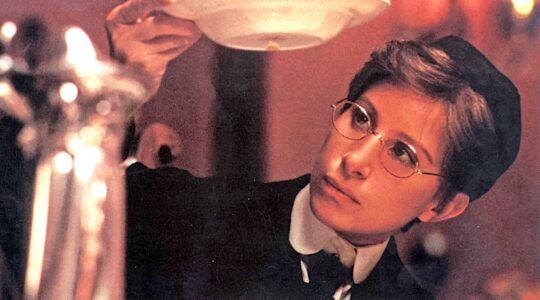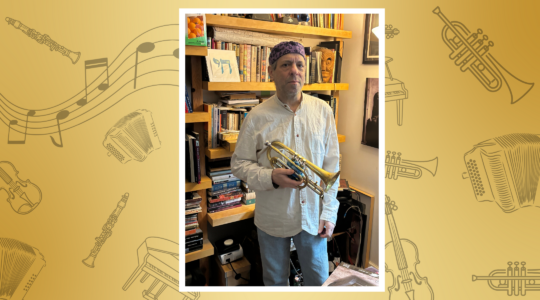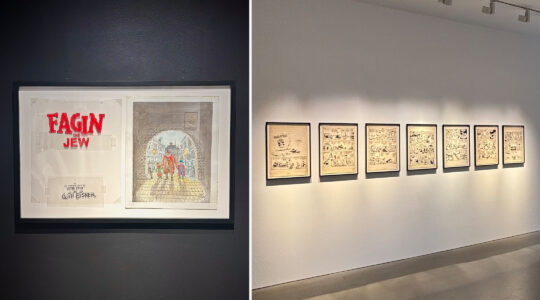One by one, 72 Torah scrolls rescued from the Shoah were carried in slow procession through Temple Emanu-El’s social hall last Tuesday evening.
This was the largest reunion ever — and the first in the United States — of these scrolls saved from long-gone synagogues throughout what is now the Czech Republic.
“This is an image none of us will ever forget,” Rabbi Joshua Davidson, senior rabbi of Temple Emanu-El, told the crowd of more than 700.
The gathering of Torah scrolls marked the opening of a new and related exhibition in Temple Emanu-El’s Bernard Museum of Judaica, “The Guiding Hand: An Exhibition of Torah Pointers from Past and Present.”
Jeffrey Ohrenstein, trustee and chairman of Memorial Scrolls Trust in London, who helped arrange the event, described these scrolls as “silent witnesses.”
In the 1940s, as Jewish communities in Bohemia and Moravia were being destroyed and the Jews deported, many of their Torah scrolls and other treasures were sent to the Prague Museum for safekeeping. Soon the museum curators too were sent to Terezin and Auschwitz, and the scrolls were removed to a warehouse. In 1964, after a Jewish philanthropist purchased them, more than 1,500 were brought to the Westminster Synagogue in London. The Memorial Scrolls Trust has worked to restore, repair and find new homes for them, placing them in Jewish communities around the world, on permanent loan, as long as the communities remain intact. One was presented to Queen Elizabeth and is in her private library, and more than 1,000 are in the United States.
Identified by number, the scrolls — brought to Temple Emanu-El from synagogues and chapels of all denominations in the tri-state area and beyond — are no longer in their original mantles; some were covered in simple white velvet, others in colorful tapestries, one in a tartan plaid and another in the stripes of a concentration camp prison uniform. Those that can no longer be read from, if the writing is damaged, are sometimes held in synagogue on Yom Kippur and danced with on Simchat Torah.
The Torahs were carried by men and woman of various ages, accompanied by a soulful violin interpretation of “Etz Hayim” (A tree of life) from Proverbs. Several people put their hands to their heart as Cantor Ronni Pressman of Bloomfield, N.J., held the Torah on loan to her synagogue in one arm, and the hand of her 2-year-old grandson in the other.
Holocaust survivor Charles Ticho, 92, who grew up in Brno, carried a small Torah from his city. He told The Jewish Week that he recalled singing in the synagogue choir in Brno and wondered if one of the scrolls may have been present, or if perhaps his older brother may have read from one for his bar mitzvah. Ticho had secured a scroll from his father’s birthplace, Boskovice, for his son’s synagogue in Bethlehem, Pennsylvania, on the occasion of his grandson’s bar mitzvah.
“These scrolls remind me of our people. Both were uprooted from their homes, transported, warehoused, numbered. Mercifully the scrolls survived,” George Klas said. He was carrying a large Torah now housed in Congregation B’nai Jeshurun in Manhattan. Klas secured the Torah scroll for BJ in 1991 and dedicated it in memory of the grandparents he never met, who were murdered at Auschwitz.
Warren Klein, curator of the Bernard Museum, told The Jewish Week, “Connecting the old with the new is a major theme in the exhibition, and in bringing together the hundreds-year-old scrolls and the present moment, with so many people present, we demonstrated strength — and that the survival of the Jewish people is reliant on our faith.”
The exhibition, “The Guiding Hand,” features more than 150 yads — pointers specifically designed for reading the Torah text — that range from centuries-old simple tapered wooden styles with the form of a hand with a pointed index finger at the end, to contemporary versions made of hand-blown glass, ivory, ornamented metals, even cement. There are elegant antique silver European pieces and modernist work by master craftsman Ludwig Wolpert. One yad was made out of bullet casings by an unknown soldier in the South Pacific during World War II.
The word yad means hand, and the pointers are used to help the reader follow the words of the text without touching the parchment, for fear of smearing the ink. Place keepers or guides, these yads are handmade, many by women artists, and are drawn from the collection of the Barr Foundation in Virginia Beach, Va. An adjacent room features examples from Temple Emanu-El’s own collection.
In showing so many examples of a single ritual object in sumptuous variety of materials, format and place of origin — from Poland to Afghanistan to Pennsylvania — the exhibition focuses on the intimate connection between reader and text, and how generations have beautified the commandment of chanting from the Torah, bringing the letters to life.
Ohrenstein may have been speaking about the yads as well when he told the gathering, “The Torah is the one thing that binds all Jews together.” He adds, “We would like our scroll holders to use the scrolls in a way that reminds people of what we have in common rather than what divides us.”
The New York Jewish Week brings you the stories behind the headlines, keeping you connected to Jewish life in New York. Help sustain the reporting you trust by donating today.




